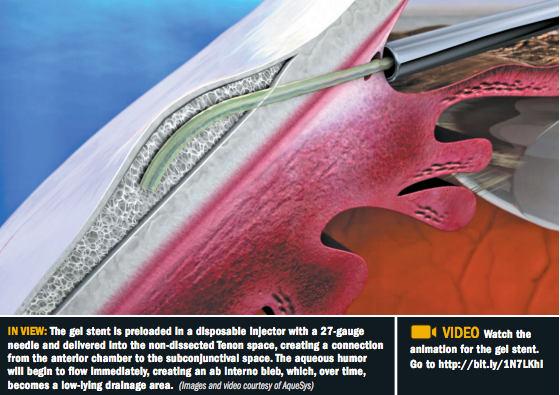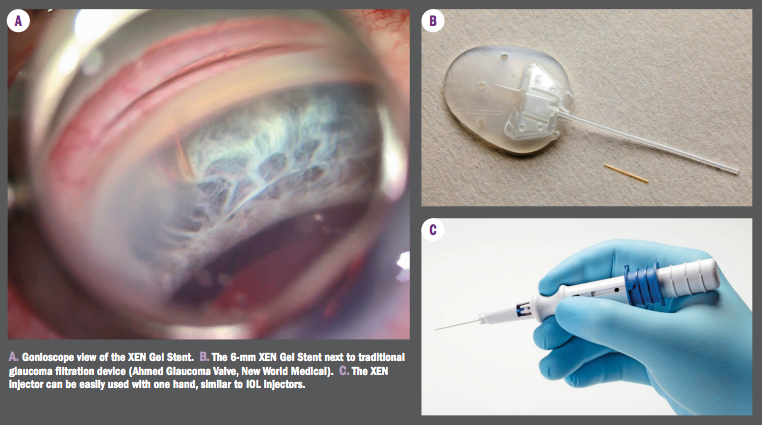Article
Gel stent brings new hope for early glaucoma patients
The initial 36-month results are highlighted from a novel, soft and permanent, minimally invasive ab interno collagen implant used to optimize aqueous drainage to the subconjunctival space.
Take-home message: The initial 36-month results are highlighted from a novel, soft and permanent, minimally invasive ab interno collagen implant used to optimize aqueous drainage to the subconjunctival space.
By Fred Gebhart; Reviewed by Herbert Reitsamer, MD
Salzburg, Austria-A minimally invasive gel stent may bring new hope for patients with early glaucomas.
Data from the largest trial to date of the device (XEN Gel Stent, AqueSys) for glaucoma support its safety and efficacy up to 3 years. The device showed a mean 40% reduction in IOP at 36 months and a 74% reduction in anti-glaucomatous medications. Pressure is drained directly from the anterior chamber into the subconjunctival space.

“Because of the safety and efficacy, we can use this stent in relatively early glaucomas,” said lead author Herbert Reitsamer, MD, Lotte Schwarz Professor of Ophthalmology, Director of the Glaucoma Service, and director, Experimental Ophthalmology, at the SALK/Paracelsus Medical University, Salzburg, Austria.
Did you know these 7 men were ophthalmologists?
“We don’t have to wait until surgery is the last resort as we do with trabeculectomy,” Dr. Reitsamer said. “This stent is also a replacement for laser procedures or an increase in eye drops than it is a replacement for trabeculectomy.”
The prospective, non-randomized, multicenter evaluation of multiple XEN models was conducted by more than 40 investigators in 13 countries. A total of 852 eyes were implanted using multiple stent models, protocols, and injectors. Of the total, 515 eyes were followed for 3 months, 224 eyes for 12 months, 70 eyes for 24 months, and 33 eyes for 36 months.
Best ophthalmic hospitals for 2015
Most of the eyes (570) were treated with the most current device (XEN 45 Gel Stent). Overall outcomes were better for this more advanced device, which has been commercialized in Canada and Europe, including a mean drop in IOP of 48.8% at 24 months. But most of the XEN 45 eyes (334) were followed for 30 days. Only 287 eyes were followed for 3 months, 166 eyes for 6 months, 73 eyes for 12 months, and two eyes for 24 months. More complete data will be reported as more eyes move toward 3 years and longer follow up.
Next: How stent performs
The stent has been approved for use in Canada and the European Union but remains investigational in the United States. Enrollment for a U.S.-based IDE study has been completed and follow-up will be complete in early 2016.
7 most common lies you've been told about optical shops
“In terms of minimally invasive stents, some of these eyes have been implanted quite some time ago,” Dr. Reitsamer said. "As the follow-up period extends, more and more eyes reach the 36-month exam. The robust pressure reduction and stability of the implant even in patients implanted early on is reassuring."

Of the stents that have been followed for 36 months, 5% were converted to another procedure. The overall conversion rates were similar at 12 and 24 months. The conversion rate for the XEN 45 is less than 2% at 12 months. The design is based on the Hagen-Pioseuille law of laminar flow and maintains a positive pressure gradient between the anterior chamber and the subconjunctival space.
How it performs
The stent is made of a cross-linked gel that injected through the anterior chamber into the subconjunctival space. It hydrates and swells on injection, creating a soft, flexible drainage channel that conforms to the ocular tissue and cannot migrate. Inflammation and erosion have not been observed as significant problems.
Next: Study outcomes examined
The outcomes of stand-alone implants and implants combined with cataract surgery were similar. At 12 months, stand-alone gel implants showed a mean drop of 47% from preoperative IOP, from 23.6 mm Hg preoperatively to 12.6 mm Hg postoperatively. That compares with a 40% mean drop for the combined cataract surgery plus gel stent, from 21.7 to 13.0. Outcomes for combined trabeculectomy and cataract surgery are typically worse than trabeculectomy alone.
Overall intraoperative safety is also better than trabeculectomy, Dr. Reitsamer said.
The most common adverse event, intraoperative subconjunctival or anterior chamber bleeding, was reported in just 1.2% of procedures. There were cataract-related complications not associated with the stent in 0.8% of procedures and lower rates of conjunctival perforation and iris damage.
Should high-volume surgerons have surgical privileges?
Postoperative adverse events were also low. Hyphema was the most common observation at 2.6%, followed by self-limiting choroidal effusion that lasted less than 30 days at 1%, shallow anterior chamber at 0.8%, viscoelastic injection into the anterior chamber at 0.6% and anterior chamber tap to release retained viscoelastic at 0.4%.
Less common events included self-limiting choroidal effusion lasting more than 30 days, corneal abrasion, allergy to postoperative medication and unrelated events including systemic conditions, hospitalizations, and death.
Safety was a particular interest because surgeons who perform superficial anterior lamellar keratoplasty routinely use the gel stent with very good results, Dr. Reitsamer said. The question was whether surgeons who may not have as much experience have similar outcomes.
Next: "We should be doing more sugeries and earlier surgeries"

“International safety results show that it really is a very safe procedure, about as safe as you can get with a minimally invasive implant,” he said.
Practice nets over $1 million from EHR adaption
Hypotony, for instance, was not an issue and bleeding was minimal.
“This stent is as effective as trabeculectomy, but I can use it much earlier because I am not so worried about the side effects of surgery,” Dr. Reitsamer said. "Considering patinet adherence and compliance, we should be doing more surgeries and earlier surgeries to better preserve vision.”
Herbert Reitsamer, MD
This article was adapted from Dr. Reitsamer’s presentation at the 2015 meeting of the American Society of Cataract and Refractive Surgery. Dr. Reitsamer did not indicate any financial interest in the subject matter.
Newsletter
Don’t miss out—get Ophthalmology Times updates on the latest clinical advancements and expert interviews, straight to your inbox.




